This is the Brompton Oratory, South Kensington, London, just today:
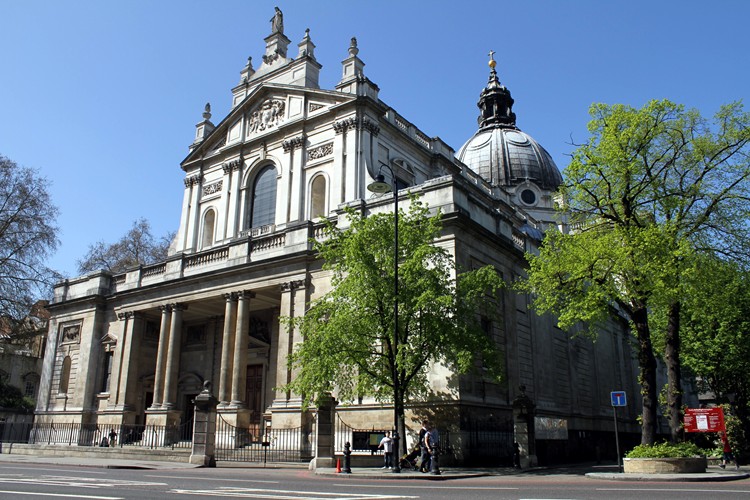
So what's the problem? The sun. It's out. In early April. And when I took the photo about two hours ago, it was 20°C outside.
More early-April madness:
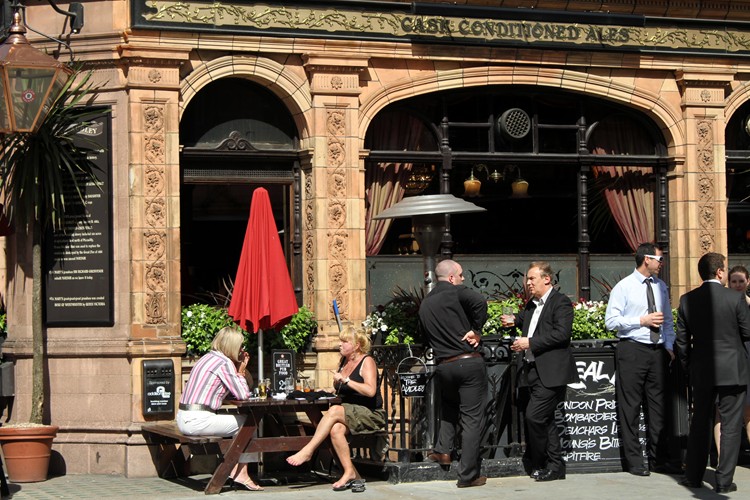
Just look, will you? Londoners eating lunch outside. Insanity!
The weather is so freakish that I've actually got a mild sunburn. A sunburn! In London! I don't even think they sell sunscreen in the UK. But I'm going to go have a look—just to make sure for myself that the weather really is this weird.
Because coming to the UK and not moaning about something would be like going to Wrigley and not having an Old Style, here goes. My troubles began last night when my plane arrived fifteen minutes early at Heathrow, and then we had to collect our bags from the spot where the baggage handlers had them waiting for us when we got through Border Control. This got me through the airport from touchdown to the Tube in 40 minutes, which is unacceptably efficient. The Tube itself cost almost £2 all the way to Central London, took nearly half an hour, and didn't even have any drunk people on it.
At least the lifts were out at Earl's Court so I could carry my bag up some stairs, and I had to deal with a comforting cock-up involving the hotel's credit-card machine, both of which made me feel like I'd gotten to the real UK. Unfortunately, the night clerk ruined it by working efficiently and professionally to get through the issue and get me checked in. Then, once that was done, I was unable not to find a curry restaurant still open, and I had to have a chicken tikka with actual spices and flavor procured by a polite and smiling—smiling, in London, the thought!—server.
Finally, this morning, when my room's Internet connection went out, the day clerk completely broke from British custom and offered to fix the problem himself, so that when I got back from getting some coffee, it worked fine.
Don't even get me started on the weather. I came all the way to the UK only to have the trip ruined by sunny skies and 20°C temperatures. I mean, not even one bloody cloud in the sky. Now I suppose I'll have to spend the entire day walking around in it, and possibly eat lunch sitting outside. One just doesn't do that in London in April; it's just not done.
I really don't know if I can take four days of this.
Chicago Public Radio is calling Chicago's 43rd Ward for Michele Smith. I don't have the final figures, but so far it looks like she spent over $1.4m—or around $150 per vote.
I hope it's worth it.
I counted the Rs. I counted the blanks. I thought of the likelihood that Terence could form any other words out of what I left him. And then, of course, it turned out he had a D:

I feel like Bill Buckner all of a sudden.
In my final installment from beautiful Hempstead, N.Y., I present two buildings that sprouted from parking lots. This one, behind Emily Lowe Hall, sits in what used to be the faculty parking lot south of Weed[1] and Adams. So far, no one has coughed up the requisite millions to rename it, so it's called "New Academic Building:"

Seriously, I'm not making up the name:
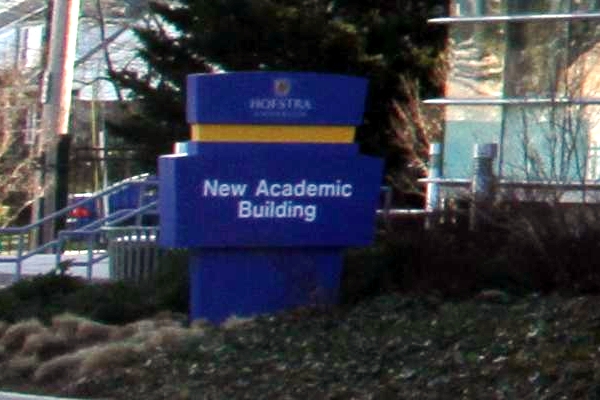
For comparison, here's a photograph taken from above the Hofstra Fair in May 1992. The new building in the photos above is in the parking lot in the lower right corner of this shot:
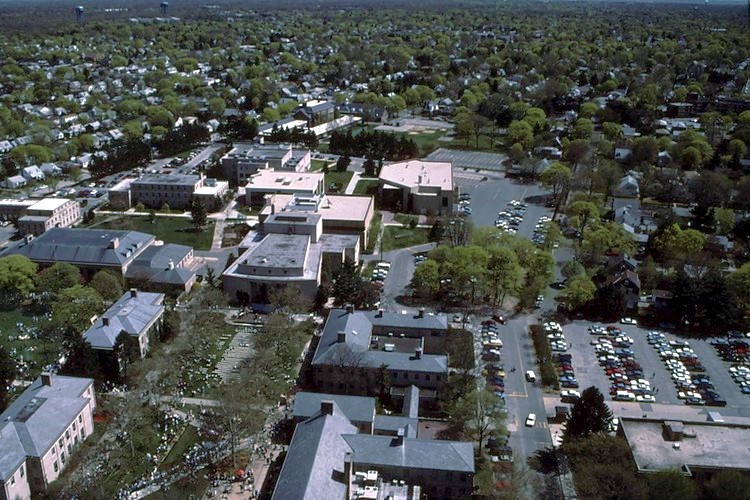
Here's the current campus map of the location:

Then, on North Campus, sprouting like a boxy steel weed from what used to be the best parking spaces on campus, is "Graduate Residence Hall:"
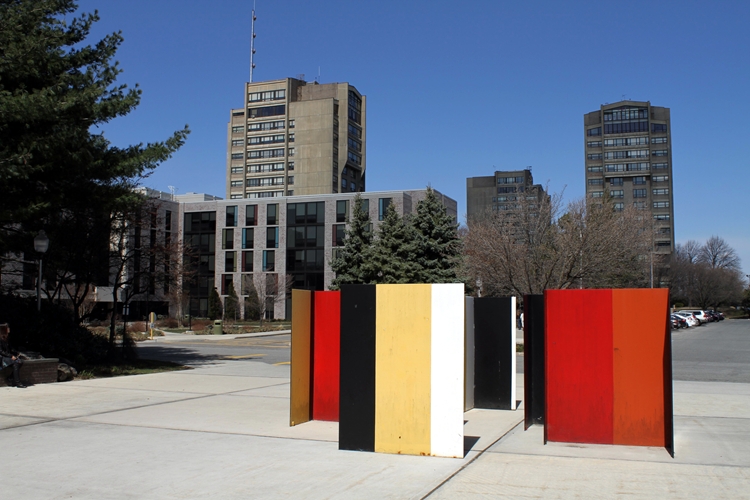
Another map inset for y'all:
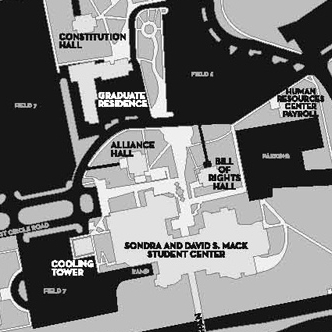
And the "before" photo:
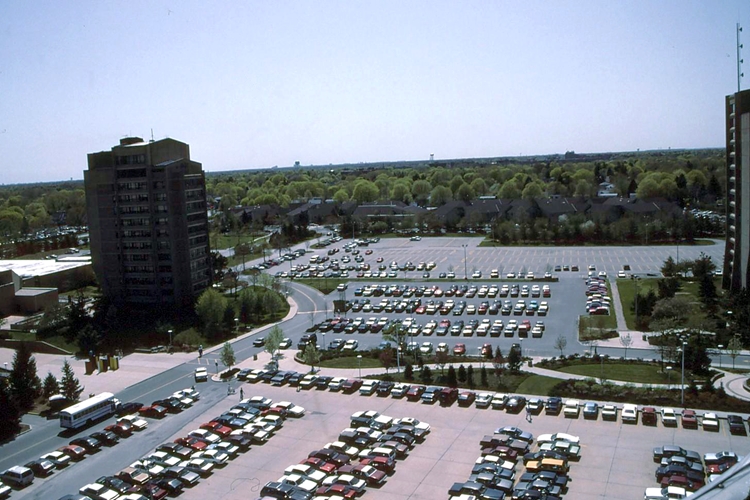
I might post a few more photos from the 1990s later. But for now, I think I'm all Hofstraed out.
Yes, Hofstra has a Weed Hall. No, they didn't put the chemistry department there.
Voters in Chicago's 43rd Ward, including I, will choose a new alderman in today's general election. The two candidates, Tim Egan and Michele Smith, have spent $387k and $1.1m respectively.
Is it really worth $1.4m to become an alderman? The ward has a population somewhere around 50,000, or about 1/12th of a U.S. Congressional district, and aldermen have almost no power in city government. Of course, they do have power over things like snow removal contracts and liquor licenses. So possibly both Smith and Egan have deep and abiding senses of civic duty, willing to sacrifice so much for the good of the city.
Not to be cynical, but perhaps it's more than that:
Aside from $3,000 in "in-kind" contributions—apparently in the form of food for fundraisers, provided by O’Brien’s Restaurant—another $22,500 was donated to the Egan campaign by four other companies that share the same Wells Street address (found here and here), and that city records show are affiliated with the O’Brien family.
... But Smith has a major contributor of her own. That would be the retired Helen Meier, of Wilmette. This election cycle, Meier has given Smith’s campaign $95,000. Going back to Smith’s previous run for alderman in 2007 and her 2008 win for Democratic ward committeeman, Meier has donated roughly $360,000 to Smith.
And this is only one race out of 14. (There are 50 wards in Chicago.) Welcome to the political earthquake caused by Mayor Daley retiring at the end of this month. Pass the popcorn.
Can they arrest you for criticizing the war?
Can they send your state's national guard to fight, even if your state opposes it?
Can they make you open your house to a few soldiers, and call you a traitor if you don't?
And can the soldiers go through your things while they stay in your house?
And if one found something illegal in your sock drawer, should you go to jail?
And if you got a lawyer, can they prevent her from using legal "tricks" to keep you free?
Can they ruin your reputation on the Evening News, even if you're not convicted of a crime?
But if you were convicted, could they make you stand naked in a cell at Guantanamo Bay for eight years?
And if you're not with them, are you against them?
Is there even any law against it?
If you answered "yes" to any of these questions, you're not alone. And that's what scares me.
(Hat tip to Sullivan for inspiration.)
Here are a couple more photos from the Hofstra, as promised. Also as promised, they might not mean anything to people who didn't live there, but to us alumni, they might bring back either memories or today's lunch. First, the original Unispan, looking north from the apex over Hempstead Turnpike:
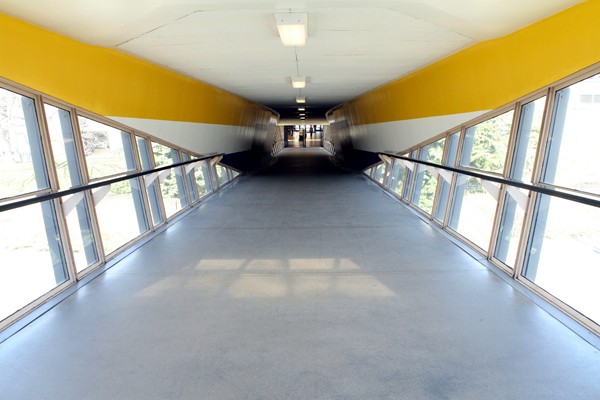
The north-central Student Center stairs, leading down to the Small Clubs Office (which has since become a game room):
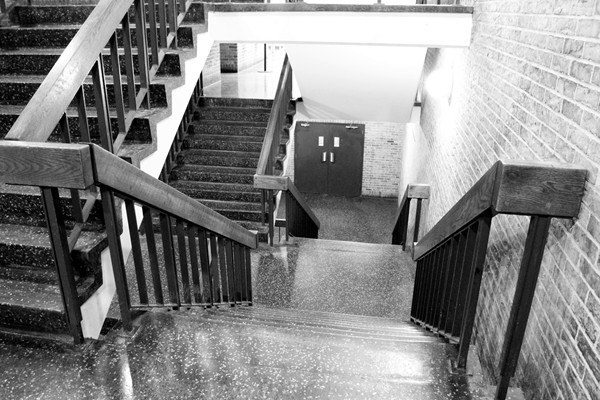
And when you need that massive dose of greasy pizza in the afternoon, where better to get a slice than the Rathskellar:

Finally (for now), a nod to everyone at HTV:
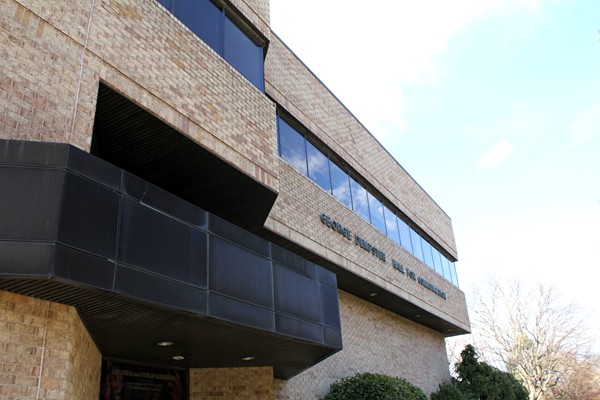
More Hofstra photos are coming soon. Before I get to those, here's an image from my drive home from O'Hare this afternoon. It's the last Cabrini Green high-rise in its death throes:

The site, on Division between Halsted and Larrabee, contained the last two high-rises of a blighted urban complex that covered over 2.5 sq km and had some of the worst crime in the city. The Encyclopedia of Chicago describes the history:
The large new apartments and large swaths of recreation space failed to mend the area's poverty. The difficulty blacks had finding better, affordable housing gave Cabrini-Green a permanent population. CHA failed to budget money to repair buildings and maintain landscaping as they deteriorated. Cabrini-Green's reputation for crime and gangs rivaled Little Hell's. The murders of two white police officers in 1970 and of seven-year-old resident Dantrell Davis in 1992 drew national attention.
Increasing real-estate values in the late twentieth century led housing officials to propose replacement of the complex with mixed-income housing. Residents argued however that such a move would displace them permanently, completing the slum removal effort begun with the building of Cabrini Homes half a century earlier.
Those "increasing real-estate values" mean that you can now spend $500k on a townhouse in the former no-go zone around Wells and North, and the Cabrini-Green site could wind up selling for many tens of millions. And if you're wondering what happened to all the project's residents, you're not alone.
I visited my alma mater for a reunion of Chronicle alumni today. I think I last saw the campus in 1999, though I might have seen it as late as 2003, but it doesn't seem that recent. No matter; except for a couple of buildings that sprouted from the North Campus parking lots, everything looks just enough like it did when I lived on campus that I feel vaguely weirded out right now. Walking into the Chronicle office, which looks pretty much the same (except with bigger computers and younger editors), made me remember so many Wednesday night layout sessions that I felt a residual wave of sleep deprivation wash over me.
Only a few people from my era came to the reunion. I blame, in no small part, the Alumni College for not reaching out to more alumni. The Chronicle invited one of my classmates to speak on a panel months ago, but he didn't receive his invitation from the alumni office until two weeks ago. A few other people I emailed didn't know anything about the event.
I didn't take enough time to shoot everything I'd hoped to, and some of the things I wanted to photograph have disappeared or moved (like the WRHU offices, which now live in their own special annex of the TV building instead of the basement of Memorial Hall as I remember them). As I offloaded the photos I realized I'd taken shots of the most evocative parts of campus to me, even though they'll look completely banal to anyone else. For example, I have two shots of a particular stairwell—the one leading from the Student Center Atrium down to what used to be the Small Clubs Offices—because seeing it brought back such an overload of memories.
Anyway, here are two less-banal shots. First, the library, which has a new extension, but otherwise looks the same as it did when it opened in the 1950s:
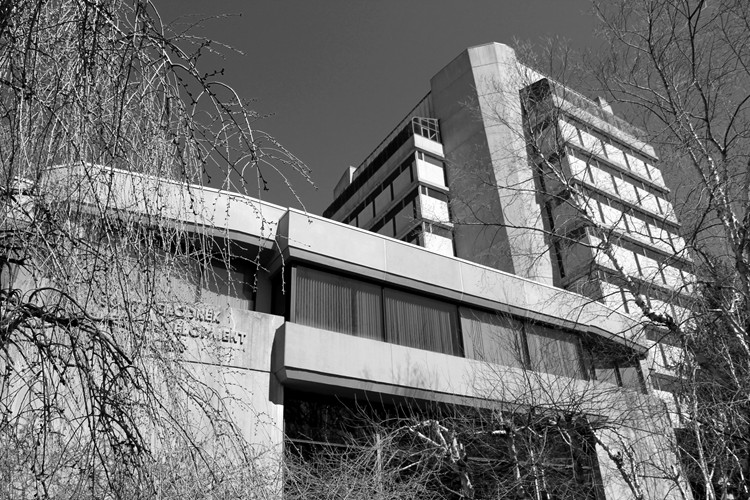
This, also, hasn't changed since 1960, if I have my information right:
